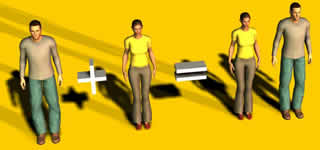There are different types of numbers, for instance:
- Z - Integers - whole numbers: ... -3, -2, -1, 0, 1, 2, 3 ... both positive, zero and negative.
 - Real
numbers - numbers which are continuous such as when we are representing points along a line - On this site I will sometimes use the term 'Scalar' to mean 'Real' numbers although strictly the term should be used when scaling a vector - In computer programs real numbers have a finite length and may have decimal point and/or exponent this allows us to approximate most real numbers but it is only an approximation.
- Real
numbers - numbers which are continuous such as when we are representing points along a line - On this site I will sometimes use the term 'Scalar' to mean 'Real' numbers although strictly the term should be used when scaling a vector - In computer programs real numbers have a finite length and may have decimal point and/or exponent this allows us to approximate most real numbers but it is only an approximation. - Q - Rational numbers - Integers and fractions where numerator and denominator are integers.
- Radical Integers - The integers plus any combination of addition, subtraction, multiplication, division and root extraction.
- Qalg - The root of a Z-polynomial - A complex number made up more than just radical integers although it is closed under sum, difference, product, quotient and nth root. (The solutions to Z-polynomials are discussed on this page).
- Modulo 'n' numbers.
There are also compound number where each element may be one of the above types.
- C - Complex Numbers - numbers with real and imaginary parts.
- H - Quaternion - Complex number whose elements are complex numbers.
- O - Octonion - Quaternion whose elements are complex numbers.
- Vectors - one dimensional arrays of numbers.
- Matrices - two dimensional arrays of numbers.
and these numbers may be coded in different ways:
- binary
- octal
- decimal
- hexadecimal
Unless otherwise specified we usually assume that numbers are decimal.
Infinity
Infinity is a number bigger than any real number
Georg Cantor, the great mathematician whose work proved to be the foundation for much of the 20th-century mathematics. He believed he was God's messenger and was eventually driven insane trying to prove his theories of infinity.
He discovered a whole hierarchy of infinities.
He devised the continuum hypothesis but failed to prove or disprove it.

